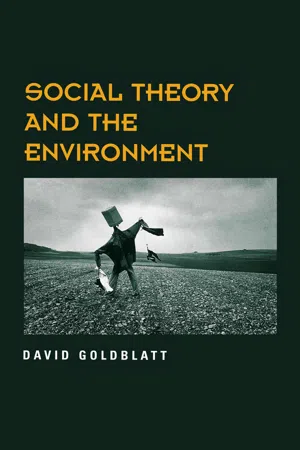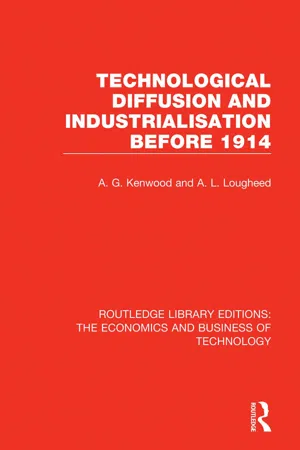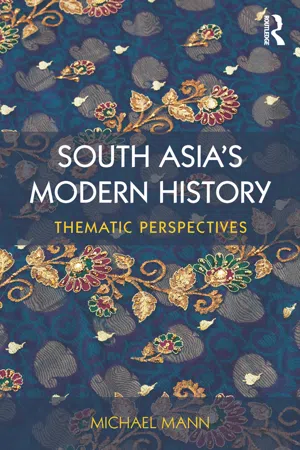Social Sciences
Industrialisation
Industrialisation refers to the process of transforming an economy from primarily agricultural and handicraft-based to one dominated by manufacturing and industry. This typically involves the introduction of new technologies, the growth of urban centers, and changes in social and economic structures. Industrialisation has historically been associated with significant shifts in employment patterns, living standards, and societal organization.
Written by Perlego with AI-assistance
Related key terms
6 Key excerpts on "Industrialisation"
- eBook - ePub
- David Goldblatt(Author)
- 2013(Publication Date)
- Polity(Publisher)
74 Indeed, directed scientific research has been instrumental in the emergence of all the most significant industrial innovations of the late nineteenth and early twentieth centuries, for example, the internal combustion engine and electricity production.I would suggest that the activities Giddens includes under the heading of industrialism necessarily entail a fairly high and complex division of labour. It is inconceivable that widespread mechanization and the array of technological development implied by industrialism could have been achieved without a significant level of differentiation in terms of employment, training and knowledge.75 Moreover, the division of labour not only occurs within the productive process itself but engenders structural differentiation across the whole economy. The process of industrialization entails not simply the rise of industry but a massive decline in the numbers of people required in agriculture and an equally rapid expansion of the service sector in all its different forms. It also requires a level of capital formation and deployment qualitatively different from that in preindustrial societies. In this respect a further elective affinity between capitalism and industrialism is that the former is capable of a level of capital formation and concentration without which the productive infrastructure of industrialism would be rendered impossible.76In assessing the environmental consequences of industrialism, there is a need for some sort of periodization – a point somewhat lost in Giddens’s analysis. Acknowledging differential rates and trajectories of industrialization, certain key technologies have transformed the productive forms and environmental impacts of industrial societies. I will not attempt to chart such a comprehensive technological history, but shifts in the dominant forms of energy production (from coal to oil and nuclear-based electricity), transportation (from horse to rail to car) and other raw material use (the rise of organic chemical use, the importance of new metals technologies) would be most important. In the context of this and the following chapters, I shall not confine myself to the environmental consequences of any one period of industrialization, although I am sensitive to the criticism that only by attending to such a periodization can the history of environmental degradation be adequately explained. - eBook - ePub
Sociology, Work and Organisation
Seventh Edition
- Tony Watson(Author)
- 2017(Publication Date)
- Routledge(Publisher)
4 Industrial capitalism, change and the possibility of a fourth automation-based industrial revolutionKey issues• What are the distinctive characteristics of the industrial-capitalist type of society and economy that is dominant in the modern world?• How did this modern industrialised type of world come about?• What transitions have sociologists identified as having occurred in the latter part of the twentieth century and the early part of the twenty-first century?• What continuities and changes are occurring in twenty-first-century post-financial-crash societies?• What part in change processes does technology play?• What can be said about the future of work? And might we be entering a fourth industrial revolution?The nature of modern societies
Sociology emerged and developed as a way of coming to terms with fundamental changes associated with Industrialisation and the rise of capitalism, as we saw in Chapter 1 . Changes in the way work is organised and experienced have been at the heart of the social and historical shifts with which sociology has always engaged. The most significant historical shift identified by sociologists was the rise of technology-based industrialism and capitalist forms of political economy. But, within this, sociologists and other social commentators have identified a variety of subsequent shifts in how the working aspects of societies are organised, using terminology like post-industrialism, post-Fordism, postmodernism and globalisation. Most recently, there has been speculation about a forthcoming fourth industrial revolution.These shifts, or alleged shifts, cannot be understood without their first being located in the historical process through which the basic form of modern societies emerged. And the most useful way to characterise the basic modern form of social organisation is as ‘industrial capitalism’. - eBook - ePub
Industrialization as an Agent of Social Change
A Critical Analysis
- Herbert Blumer(Author)
- 2018(Publication Date)
- Routledge(Publisher)
We may construct out of scholarly thought a fifth way of viewing industrialization. This view is to be found chiefly in sociological writing. In the main, it takes or presupposes a number of the logical demands discussed above, but elevates them to a higher level of generality. These items of higher generality are viewed as processes or broad social forces, intrinsic to industrialization, which push into group life and determine major lines of its organization. Taken together they constitute a kind of general social system, which molds social life to its form. All of the features that I am mentioning can be seen in the following list of general social processes that are frequently identified with industrialization:- Increasing occupational specialization and a greater division of labor.
- Detachment of production from family and village institutions and its lodgment in a separate institution with its own distinctive character.
- The formation of a new class structure through the articulation of the divergent participants in the industrial system.
- The organization of a new system of prestige, authority, and power.
- Accelerated processes of physical and social mobility.
- The process of urbanization.
- The secularization of values, institutions, and social relations.
- The generation of impersonal social relations, replacing personalism and paternalism.
- A process of individuation (the detachment of individuals from social groups, a kind of atomization of society).
- A shift from status by ascription to status by achievement, i.e., from an evaluation of an individual on the basis of birth, family, etc., to an evaluation of him on the basis of his abilities and performance.
- A shift away from traditional mindedness, and the development of a disposition favorable to innovation and social change.
The items listed above are not regarded as products of industrialization. Instead, they are advanced as processes or forces intrinsic to industrialization. They represent industrialization at work, constituting the ingredients that make up industrialization as an agent of social change. Thus, each item is one way in which industrialization operates on group life—one line along which it exercises influence. As in the case of the “logical demands” of the previous view, the “forces” or “processes” of the present view are regarded as striving for realization, as relentlessly pushing out to mold society in terms of their form. Thus, again, like the logical demands of the previous view, the processes of the present view are thought of as exercising influence along determined lines to determined results. - A. G. Kenwood, A. L. Lougheed(Authors)
- 2018(Publication Date)
- Routledge(Publisher)
Other heavily industrialised regions also developed in parts of Germany (Silesia), Austria-Hungary, Russia, Sweden, Denmark and Finland, but by 1924 the greater part of Europe’s industrial development was concentrated along a line running from northern France through to northern Italy. Finally, over time, the spread of Industrialisation was, broadly speaking, from the more-advanced economies to the less-advanced. In other words, other things being equal, the later a country entered the Industrialisation process the more backward economically and socially it tended to be. 1 In reviewing the spread of Industrialisation during the nineteenth century it is convenient to make use of Rostow’s concept of the take-off, which, in terms of his theory of the stages of growth, represents the crucial stage in a country’s industrial development. 2 According to Rostow there are five stages in the process of modern economic growth. The starting point of the growth process is the traditional (pre-industrial) society in which the social structure is hierarchical, and the value system is geared to long-run fatalism. But the essence of the traditional society is that it possesses a low ceiling of attainable output per head because of the backward nature of its technology. As Rostow says, its production capabilities are based on pre-Newtonian science and technology and pre-Newtonian attitudes towards the physical world. The second stage of growth, during which the preconditions for take-off are developed, involves important non-economic and economic changes. In the non-economic sphere what is significant is the emergence of a new elite who regard economic modernisation as being not only possible but also highly desirable- eBook - ePub
South Asia's Modern History
Thematic Perspectives
- Michael Mann(Author)
- 2014(Publication Date)
- Routledge(Publisher)
110 Meanwhile, it is this latter argument that has achieved prominence in the academic research.Urbanisation
From a vernacular scientific perspective, the term “urbanisation” has a double meaning. On the one hand, the term points towards a quantitative parameter measuring the rapid growth of cities in the nineteenth and twentieth centuries in terms of space and population, particularly in industrialising countries. On the other hand urbanisation can be seen as the qualitative extent to which a specific urban society and an urban lifestyle have formed. From a sociological viewpoint, urbanisation is concerned with the expression and shaping of different areas of life and behaviour whereby a strong differentiation and high intricacy are characteristics of the urban area. Urbanisation asks questions of urban planning to produce orderly settlements for the growing population, which in turn implied a multitude of municipal management requirements such as urban water supply, waste water disposal, waste disposal, sewage disposal, public bathing facilities, educational institutions (schools, libraries, universities) and health care (hospitals, health departments). The acquisition, organisation and institutionalisation of new urban functions are all hallmarks of a tendency towards the centralisation of municipal administration.111Seen historically, the population growth in the major cities of British India is not due solely to the rural–urban migration flow but, as elsewhere in the world, also a result of natural population increase. Various estimates place the all-India population from 1750 to the 1800s between 150 and 200 million people. By 1850 estimates of British India and adjacent regions held that the population had reached roughly 240 million people. Meanwhile, the first Census of India, which was conducted by the British in their provinces in 1871 and complemented by estimates from the monarchies and principalities, resulted in a total population of 250 million people, whilst the Census of India of 1901 saw the population grow to 285 million inhabitants.112 - eBook - ePub
- Harold Perkin(Author)
- 2003(Publication Date)
- Routledge(Publisher)
It was a revolution in men’s access to the means of life, in control over their ecological environment, in their capacity to escape from the tyranny and niggardliness of nature. At the material level it can be described as a rise in human productivity, industrial, agricultural and demographic, on such a scale that it raised as it were, the logarithmic index of society: that is, it increased by a multiple (rather than a fraction) both the number of human beings which a given area of land could support, and their standard of life, or consumption per head of goods and services. In the course of six centuries after the Norman Conquest the population of England and Wales perhaps quadrupled, while for the majority of the people the standard of life fluctuated between actual starvation and mere poverty, and rose, when at all, with painful slowness. During the nineteenth century population more than trebled, while per capita industrial production and real income quadrupled. Such a rise in the scale of life required, involved and implied drastic changes in society itself: in the size and distribution of the population, in its social structure and organization, and in the political and administrative superstructure which they demanded and supported. It was in brief a social revolution: a revolution in social organization, with social causes as well as social effects. This view implies that the Industrial Revolution was—and is—a unique phase of historical development: the one-way road which, if travelled successfully, leads from the undeveloped society’s comparative poverty, insecurity, and dependence on the bounty of nature to the comparative wealth, security and freedom of choice of the developed society
Learn about this page
Index pages curate the most relevant extracts from our library of academic textbooks. They’ve been created using an in-house natural language model (NLM), each adding context and meaning to key research topics.





